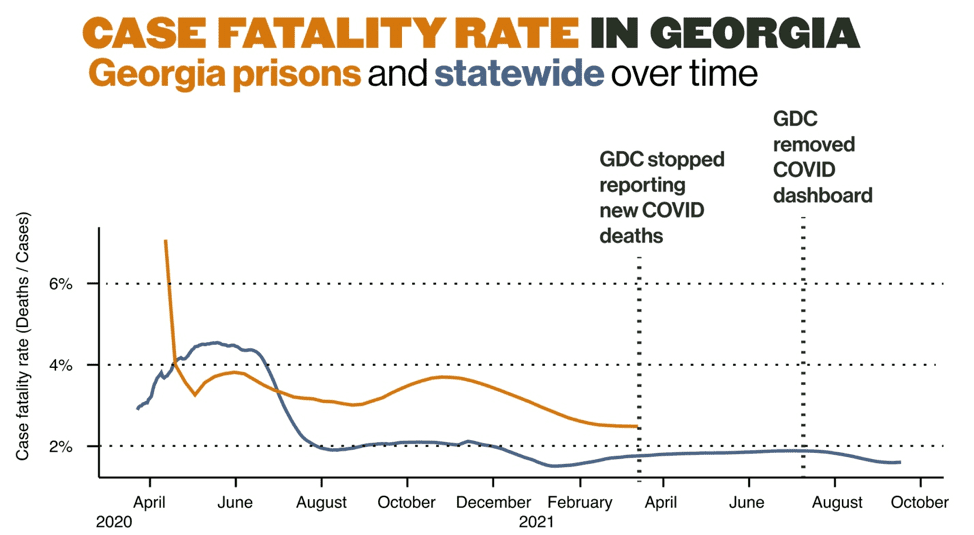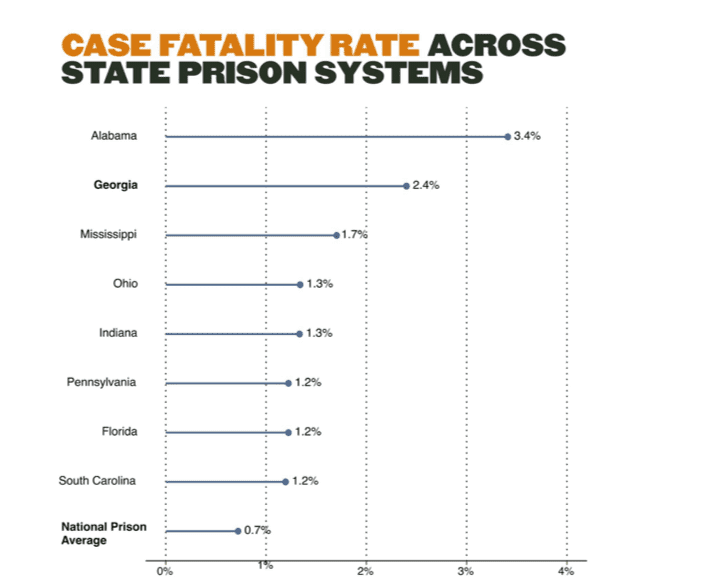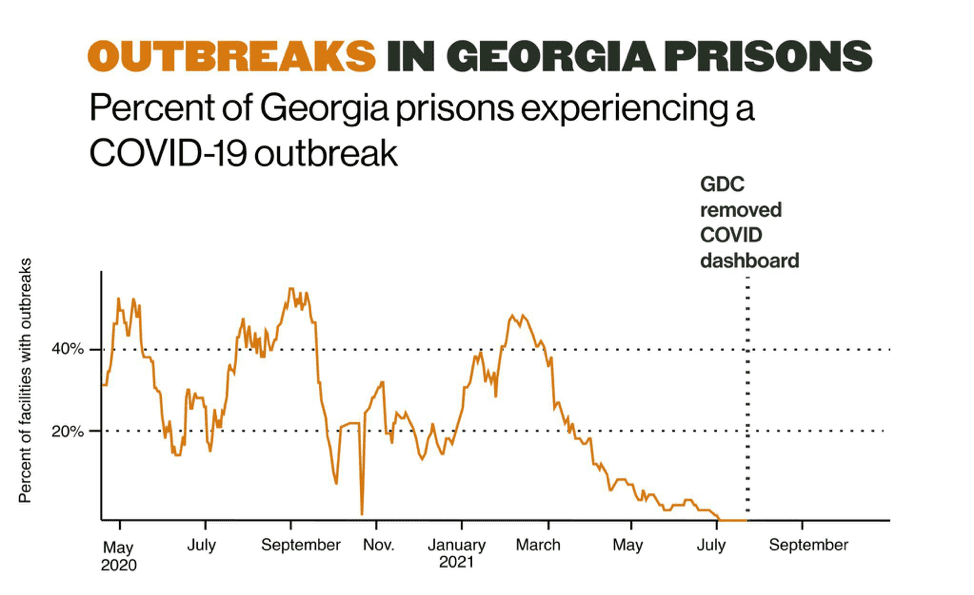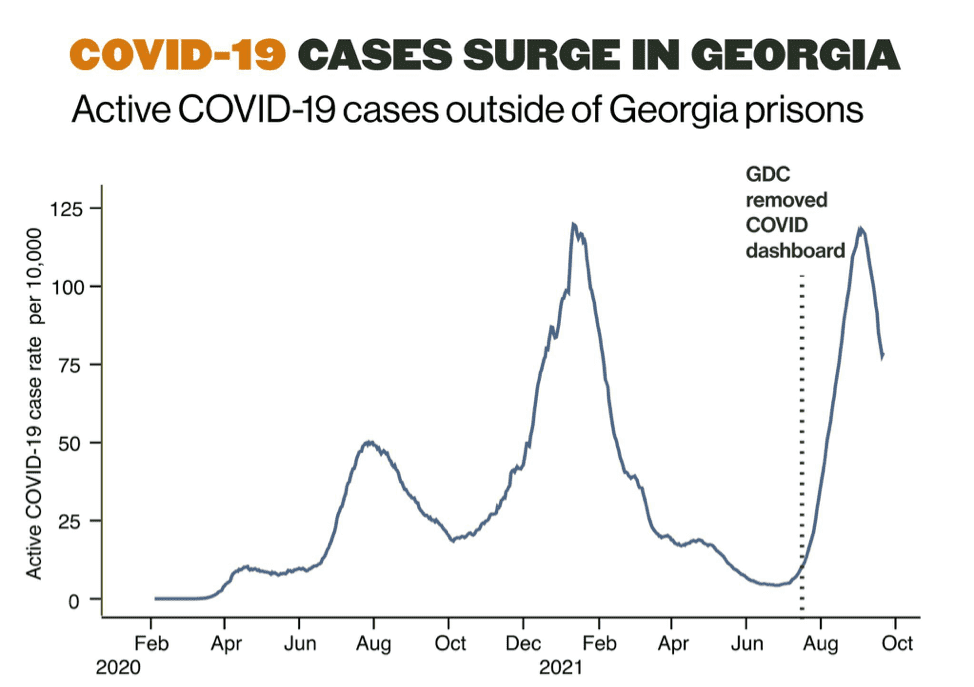September 24th, 2021
Testimony to Georgia House Democratic Caucus Committee on Crisis in Prisons
This week, our staff testified before a Georgia House Committee on Crisis in Prisons. We provided information on the lack of data transparency and reporting in Georgia state prisons, as well as the unusually high case fatality rate inside. Our testimony is as follows:
My name is Hope Johnson, and I am a data scientist at the UCLA Law COVID-19 Behind Bars Data Project. I have a background in health data analysis and, together with my team of data scientists and health researchers, I’ve spent the past year tracking the pandemic in jails, prisons, and detention centers across the United States.
My organization, the UCLA Law COVID-19 Behind Bars Data Project, tracks and reports on the pandemic in these settings and is the primary source of data on the pandemic in prisons for the Centers for Disease Control and Prevention. In addition to collecting and analyzing data, my team advocates for greater transparency and accountability around pandemic responses within and by correctional institutions.
Several times per week, my colleagues and I collect data on the number of COVID-19 cases, deaths, tests administered, and vaccinations from state departments of corrections. The lack of transparency and consistency in data reporting by the Georgia Department of Corrections (GDC) has made this task very challenging for the state.
According to data reported by the GDC, 93 incarcerated people in and four staff members of Georgia state prisons have died of COVID-19 since the beginning of the pandemic. Countless more have been infected, but because the agency doesn’t report any testing data, we do not know whether most cases, or alternatively very few cases, have been detected. We do know that at least 3,875 incarcerated people have been infected, and at least 1,752 staff members have been infected.
The GDC has the second-highest case fatality rate, or percent of those with reported infections who die, among all prison systems in the United States. In Alabama, the only state with a higher case fatality rate than that of Georgia, we know that COVID-19 testing is inadequate because testing data is publicly reported.


A number of factors could be driving the high case fatality rate in Georgia prisons: an unusually high COVID-19 death rate (which suggests other types of abuse or negligence are likely taking place), under-detection of total COVID-19 cases, or a combination of both.
Since March 14th, 2021, GDC has not reported any new COVID-19 deaths among the people in its custody. This is surprising given that throughout the pandemic, an average of 5.4 new deaths were reported each month. We do not know how many people have died of COVID-19 in GDC custody since mid-March of 2021, but that number is almost certainly higher than zero. The refusal of the GDC to report this essential public health information is a dereliction of their duty to protect the health and safety of the people of Georgia, and to be accountable to the public and to the legislators who have called this hearing.
COVID-19 outbreaks among both incarcerated people and staff members have been widespread and long-lasting. Since the beginning of the pandemic, an average of 27% of Georgia state prisons were experiencing a COVID-19 outbreak as defined by the CDC, and this is almost certainly an underestimate. In September of 2020, over half of all Georgia state prisons were experiencing an active COVID-19 outbreak. One of the worst outbreaks took place in Coweta County Correctional Institution, where in December of 2020, more than half of all people behind bars had an active COVID-19 infection.

On July 19th, the GDC took down their data dashboard entirely, claiming this decision was “due to the declining number of COVID-19 cases” and “successful vaccination rates.” As soon as the dashboard was removed, the worst of the pandemic took hold outside of Georgia prisons as the Delta variant surged throughout the state.

Although GDC cited high vaccination rates as justification for taking down their COVID-19 dashboard, the rate of vaccination among prison staff was very low. Only 24% of GDC employees were reported to have been vaccinated at the time of the announcement, and only 62% percent of incarcerated people in Georgia had received at least one dose of the vaccine at that point.
Even before the GDC removed their dashboard, poor data reporting practices have almost certainly concealed cases and deaths in prisons. In June of 2021, our organization rated the data reporting and quality of each state department of correction with a scorecard. We assigned the GDC a failing grade for low data quality and missing key variables. Most notably, Georgia included no testing information or active case counts in their COVID-19 tracker.
The lack of testing information, in particular, makes it extremely difficult to contextualize and trust the COVID-19 case data that was being reported by the GDC before they halted all public reporting of data.
It’s important to emphasize that rather than improving the quality of their publicly reported data, the GDC has stopped reporting COVID-19 data altogether, making unfounded claims about the high rates of vaccination inside their facilities and among staff instead of carrying out their duty to the public.
Now is the time for state officials to take resolute steps to gain control over COVID-19 in Georgia’s prisons. This starts with the basics: ramping up testing and publicly reporting rates of infection and death for each facility. Other necessary steps include mandating vaccines for prison staff, improving access to health care, and reducing the number of people in prison. The culture of secrecy and resistance to oversight at the Georgia Department of Corrections presents a significant threat to public health and safety.
Thank you.
next post
September 29th, 2021
Study: Hispanic people in Texas prisons dying of COVID-19 at rate double their White peers, Black people dying at rate 1.6 times
A survey of deaths in Texas prisons found that Hispanic and Black populations in prison have died of COVID-19 at rates far exceeding their White peers.